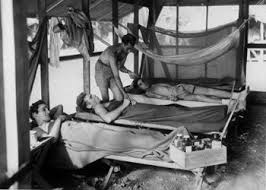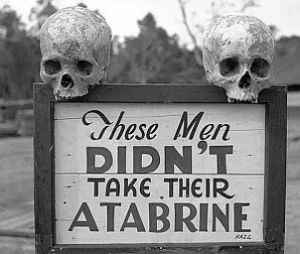In the beginning of the Second World War, a disease called malaria proved to be heavily detrimental to the allied forces and their fight against dictatorship. Malaria, which produces extremely high fevers and other flu-like symptoms due to a specific infected mosquito bite, was the cause of death for roughly 500,000 American soldiers at the dawn of World War II. In addition to high fevers, excessive sweating and the chills were also among the common symptoms of malaria, which had the power to put soldiers out of combat for up to a week or more.
Malaria is transmitted when a type of mosquito called Anopheles, more specifically a female Anopheles, is contaminated with a special species of Plasmodium. Although the American army endured numerous variations of malaria, Plasmodium vivax (or vivax malaria) and Plasmodium falciparum (or falciparum malaria) were the most prevalent. Because vivax malaria had the ability to greatly attenuate the immune systems of infected soldiers, those diseased were at greater risk to secondary infections that could result in death.

Source: http://www.nydailynews.com
As one would guess, a cure or preventative drug for malaria was desperately needed in order to provide treatment to the ever-increasing number of malaria cases (which had struck four times for every one soldier working with the allies in the Pacific by 1943).

Source: http://www.motherjones.com
Following World War I but prior to World War II, controversies on how to approach malaria arose between the Malaria Commission (League of Nations) and the International Health Division (Rockefeller Foundation). The Malaria Commission believed that using drugs against malaria was the best way to combat the disease. However, the International Health Division wanted to wipe out the parasites that spread the disease, the Anopheles mosquito. With the intention of using both methods during World War II, several soon realized that destroying the Anopheles mosquitoes while fighting would be very difficult. As a result, researchers solely focused on controlling malaria outbreaks through prophylactic drugs.
Due to the pressing health conditions of soldiers at war, both civilian and military scientists from America came together with allied scientists to discover a sound cure for malaria as quickly as possible. Toward the end of 1943, scientists had proven that the German drug atabrine could cure falciparum malaria. Atabrine was to replace the original treatment used to fight malaria called quinine. Quinine was derived from the bark of cinchona trees and approximately 90% of its supply came from Java (an island in Indonesia). But when the Japanese took over Java, that supply was swiftly cut off. However, atabrine (and no other drugs) had yet to cure vivax malaria.

Source: http://www.microkhan.com
With unwavering tenacity to find another antimalarial drug that was superior to atabrine and could combat vivax malaria, the collaborated research of civilian and military scientists in America continued to intensify. After numerous more trials and studies were conducted among organizations throughout the nation, scientists had a breakthrough with a drug named chloroquine. In early 1945, the drug showed positive results on soldiers in combat. Chloroquine not only cured falciparum malaria as adequately as atabrine did, but it also effectively suppressed vivax malaria!
By the time World War II had concluded, it was obvious that chloroquine had surpassed atabrine. Although over a million American casualties during World War II were a result of malaria, the disease has become much more controllable due to the extensive research and medical breakthroughs of effective antimalarial drugs in the interim of World War II.